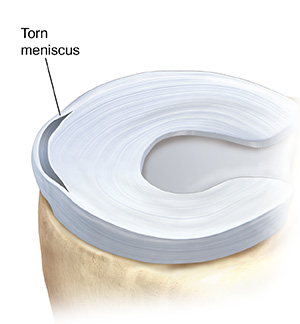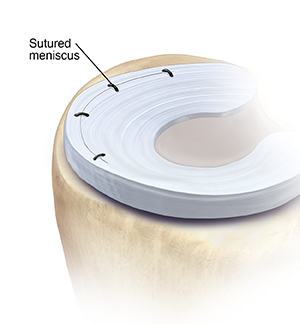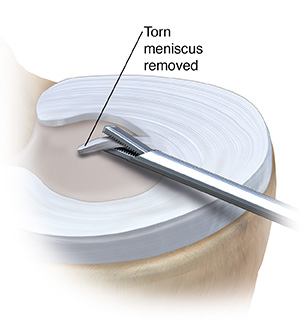A
B
C
D
E
F
G
H
I
J
K
L
M
N
O
P
Q
R
S
T
U
V
W
X
Y
Z
Topic IndexLibrary Index
Click a letter to see a list of conditions beginning with that letter.
Click 'Topic Index' to return to the index for the current topic.
Click 'Library Index' to return to the listing of all topics.
Surgery for Meniscus Tear
The meniscus is a tough cartilage pad that cushions the inside of the knee joint. The type of surgery you have depends on the nature of the meniscus tear, its size, and location. Your surgeon may use arthroscopy. This method involves putting a tiny camera inside your knee, so that your healthcare provider can clearly see your joint. Arthroscopy needs only small incisions (cuts). You can usually go home the same day as surgery. During surgery, you may have:
-
Local anesthesia. Your healthcare provider numbs your knee with medicine.
-
A regional block. Your body is numbed from the waist down.
-
General anesthesia. Your healthcare provider gives you drugs to put you into a deep sleep so you do not feel pain.

Pre-op checklist
-
Follow any directions you are given for not eating or drinking before surgery.
-
Arrange for someone to drive you home after surgery.
-
Tell your healthcare provider if you take any medicine, supplements, or herbal remedies.
Repair
For certain tears, your surgeon will try to repair the meniscus. They will sew the torn edges so they can heal correctly. Or your surgeon will use special fasteners to repair damage. In some cases, repairs may need another incision at the back or side of your knee.

Removal
In most cases, your surgeon will remove the damaged part of your meniscus. The meniscus won't completely grow back, so your surgeon will remove as little tissue as possible. Other tissue, called the articular cartilage, will take over the role as shock absorber for your knee joint.

After surgery
You'll spend some time in the recovery area. You can go home when you've recovered from the anesthesia. Your knee will be bandaged. You may have stitches, surgical tape, or staples. You may need crutches to keep weight off the knee and may have a splint or brace for support.
Online Medical Reviewer:
Rahul Banerjee MD
Online Medical Reviewer:
Raymond Turley Jr PA-C
Online Medical Reviewer:
Stacey Wojcik MBA BSN RN
Date Last Reviewed:
8/1/2023
© 2000-2025 The StayWell Company, LLC. All rights reserved. This information is not intended as a substitute for professional medical care. Always follow your healthcare professional's instructions.